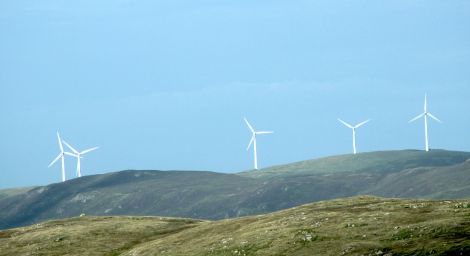News / Firms plot big windfarm in Yell and Unst
EIGHTEEN companies in Shetland are joining forces to investigate building a major new onshore wind farm in Yell and Unst.
Initial investors who have begun development work on the project – which could result in a 150-200MW wind farm capable of powering tens of thousands of homes – include firms involved in the engineering, transport, building, retail, farming and seafood industries.
Scoping work for the Energy Isles project will begin shortly, though no specific sites have been identified and no choices have been made yet about the size and number of turbines.
Any proposed development would hinge on the laying of a 600MW, 300km-long inter connector cable proposed to hook Shetland up to the national grid.
Scottish Hydro Electric’s transmission arm SHETL hopes to lay the cable later this decade, but only if Viking Energy’s controversial 103-turbine wind farm goes ahead.
It is currently the subject of a judicial review, with a Scottish Government appeal against last year’s decision to quash the 370MW project’s consent due to commence at the Court of Session in Edinburgh on Thursday.
While that project has deeply divided opinion, those involved in Energy Isles express confidence that there is “strong” community support for a large wind farm in Yell and Unst, with five of the 18 companies investing based in the two islands.
One of those is Uyeasound crofter Derek Jamieson, who said a large-scale wind farm would “bring jobs, money and community benefit which are sorely needed in Unst and Yell”.
Unst in particular has suffered major depopulation in the past decade following the closure of the RAF’s base at Saxa Vord and the closure of its airport.
North Yell Development Council hopes to have its five-turbine project near Cullivoe up and running in the next couple of years after being granted a connection to the local grid.
Become a member of Shetland News
In 2010 German company Enertrag began making plans for up to 17 turbines to be built near Burravoe in the south east part of Yell. It is unclear whether that project, also reliant on a subsea cable to the mainland, will reach fruition after Enertrag pulled out of the UK in November.
“When the interconnector cable links Shetland to the national electricity grid, it is clear that there will be plenty of headroom on it for us to export additional clean energy from a wind farm in the North Isles,” Jamieson said.
“We can either sit back and let outside companies come in and provide that – they are already looking here – or we can seize the initiative and do it ourselves. We have chosen to start the ball rolling ourselves.”
A wind farm split between Yell and Unst would require smaller subsea cables across Bluemull Sound and Yell Sound, enabling energy to be sent to Viking Energy’s proposed converter station at Kergord. It would then be sent via cable to Caithness.
The full list of those involved through their respective businesses is: George William Anderson, farmers Brian and Maurice Anderson, builder Bobby Elphinstone, Allan Jamieson, Derek Jamieson and his wife Cheryl, toy shop owner Harry Jamieson, Gary Johnson, John Henderson of Ocean Kinetics, transport hauliers Steven and Trevor Henderson, Ivor Johnson, L&M Engineering’s Steven Laurenson, David Niven, Frank Odie and Bertie Couper, David Reid, Paul Riddell, Bob Spanswick, Yell community council chairman Dan Thompson and Angus Ward of Shetland Aerogenerators, which operates the Burradale wind farm.
Investors said there had already been some interest from local individuals outwith the business community in becoming “subscribers” in the project and they anticipate that will grow as the plans develop.
Yell-based Odie cited “a lot of support” for renewables in the north isles and said he had “no doubt that a well-sited wind farm in Yell/Unst equipped with modern turbines will be a solid investment”.
Odie hopes it will provide an economic boost through jobs and community benefit which could help address “problems of depopulation, ageing housing stock and lack of adequate investment that the islands face”.
Managing director of marine engineers Ocean Kinetics John Henderson said it was “vital” for Shetland companies to become directly involved in renewables.
“The skills are all here – in development, in engineering and in technical knowledge and understanding,” he said.
“Shetland’s economy is booming at the moment, but a quick glance at our history will tell you how fragile island economies are, how prone they are to peaks and troughs in fishing and oil.”
Viking Energy’s head of development in Shetland Aaron Priest welcomed the project: “It’s great to see local people coming together with… confidence and positive attitude,” he said.
Priest said the potential jobs and income would be of “immense help” in building a brighter future for north isles folk. The 150-200MW of energy would be within the spare capacity of the 600MW connector required for Viking, he continued.
“It would still leave room for the electricty from small wind farms already planned by other groups and individuals in Shetland as well as from the Aegir wave farm and other potential projects,” Priest said.
He added that Viking would be willing to offer support and advice to those involved in Energy Isles.
Become a member of Shetland News
Shetland News is asking its many readers to consider paying for membership to get additional features and services: -
- Remove non-local ads;
- Bookmark posts to read later;
- Exclusive curated weekly newsletter;
- Hide membership messages;
- Comments open for discussion.
If you appreciate what we do and feel strongly about impartial local journalism, then please become a member of Shetland News by either making a single payment, or setting up a monthly, quarterly or yearly subscription.



























































